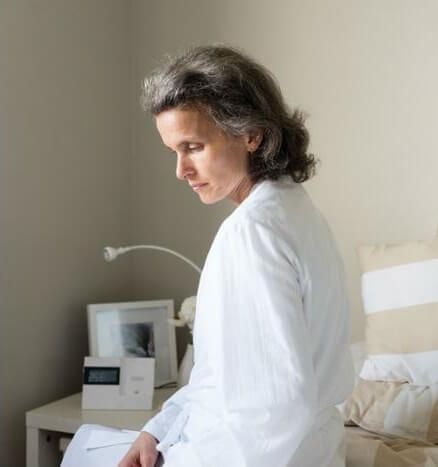We Answered: If you are shy about asking about Postmenopausal Bleeding

Very often, women after menopause relax and stop carefully monitoring their health. That is why some patients do not pay due attention to postmenopausal bleeding which is a huge mistake. Bloody discharge of any kind after the cessation of menstruation is not the norm and requires urgent medical advice.
Postmenopausal bleeding is a signal for immediately contacting a gynecologist. If a woman has had menopause (there has not been single menstruation in the last year), this always requires oncological alertness. If there is blood discharge after the 12 months absence and more, it’s not recurring menstruation or “ovaries waking up”, as women sometimes think. This is an occasion to visit a gynecologist and conduct an examination.
A doctor will conduct a routine examination, which every woman must undergo without fail once a year, regardless of age, presence or absence of sexual activity, regularly menstruating or in menopause. Ultrasound of the pelvic organs, colposcopy (examination of the cervix) and laboratory diagnostics will come to the rescue.
Postmenopausal Bleeding Causes
The most common causes of postmenopausal bleeding are considered to be:
- hormonal disorders;
- the formation of fibroids;
- polyps;
- vaginitis;
- endometrial cancer;
- hyperplastic processes in the endometrium;
- impaired functioning of the endocrine system.
In addition, this condition may be the result of the presence of ovarian or uterine tumors.
What is the Most Common Cause of Postmenopausal Bleeding? Endometrial cancer
The endometrium is the uterine mucosa and that is why, in some cases, endometrial cancer is called uterine cancer. This is the most common cause of postmenopausal bleeding.
The main sign of endometrial cancer is postmenopausal bleeding. A woman who has reached menopause should not neglect blood secretions. At the first sign, you should consult a specialist. The sooner you detect cancer of the uterus, the easier it is to cure it, without resorting to removing the uterus. In order to diagnose endometrial cancer, a woman should undergo an ultrasound scan, hysteroscopy, an endometrial biopsy, and other methods.
Treatment of uterine cancer is based on the type of cancer and its stage, on a woman’s age and other factors. As the main methods of treating this kind of cancer, chemo- and radiotherapy, as well as surgical intervention, are used.
Diagnostics of the Postmenopausal Bleeding
The diagnosis of bleeding after menopause begins with an examination by a gynecologist, who assesses its intensity and determines the nature of blood secretions from the genital tract (from the uterus or vagina or from the cervix). Based on the examination data, the doctor determines the type of bleeding (dysfunctional and others). Further diagnostics include instrumental and laboratory research methods:
- biochemical and general blood tests (to clarify the degree of anemia and identify violations in the work of other organs);
- coagulogram (blood coagulation is evaluated);
- determination of hormonal levels (estradiol and progesterone, LH and FSH, thyroid hormones and tumor markers);
- ultrasound with a transvaginal sensor (exclude uterus and appendage pathology, pregnancy);
- dopplerography (to evaluate blood flow in the uterine arteries);
- hysteroscopy followed by curettage;
- separate diagnostic curettage of the cervical canal and uterine cavity;
- histological examination of the materials obtained.
According to the indications, MRI and hysterosalpingography are prescribed, which help diagnose submucosal myomatous nodes and endometrial polyps.
Postmenopausal Bleeding Workup
In the case of postmenopausal bleeding, a woman should immediately consult a doctor, and in case of excessive blood discharge and the appearance of signs of posthemorrhagic anemia (weakness, loss of consciousness, dizziness), call an ambulance. Treatment of any bleeding during the postmenopausal period is carried out only in a hospital and begins with separate curettage, which is not only diagnostic but also therapeutic. After curettage, drug therapy is prescribed.
Common treatments for postmenopausal bleeding causes include:
- medicines
- surgical intervention (in advanced cases);
- ultrasound ablation in the diagnosis of uterine fibroids;
- resection of uterine tissues with adenomyosis;
- hormone replacement therapy;
- embolization with the introduction of medicines to block the access of blood to the uterine cavity;
- laser intervention for the purpose of burning, destruction of endometrial tissue with endometrial hyperplasia;
- neoplasm resection.
Prevention of Bleeding After Menopause
In order not to provoke the development of postmenopausal bleeding, it is necessary to:
- refuse to take hormonal drugs without a prescription. Only the doctor has the right to decide which medicine will be effective in a particular situation.
- follow all instructions and requirements of a specialist, do not self-medicate.
- take hormonal drugs in a timely manner, avoiding gaps.
- minimize physical activity, replacing them with yoga and
- reduce the effects of stress, get enough sleep and rest.
- systematically undergo medical examinations.
For a woman in the postmenopausal period, a healthy diet is incredibly important. A diverse meal rich in fresh vegetables and fruits will not only improve metabolic processes in the body but also help avoid the development of complications in the form of bleeding.
839GYLCCC1992



Leave a Reply